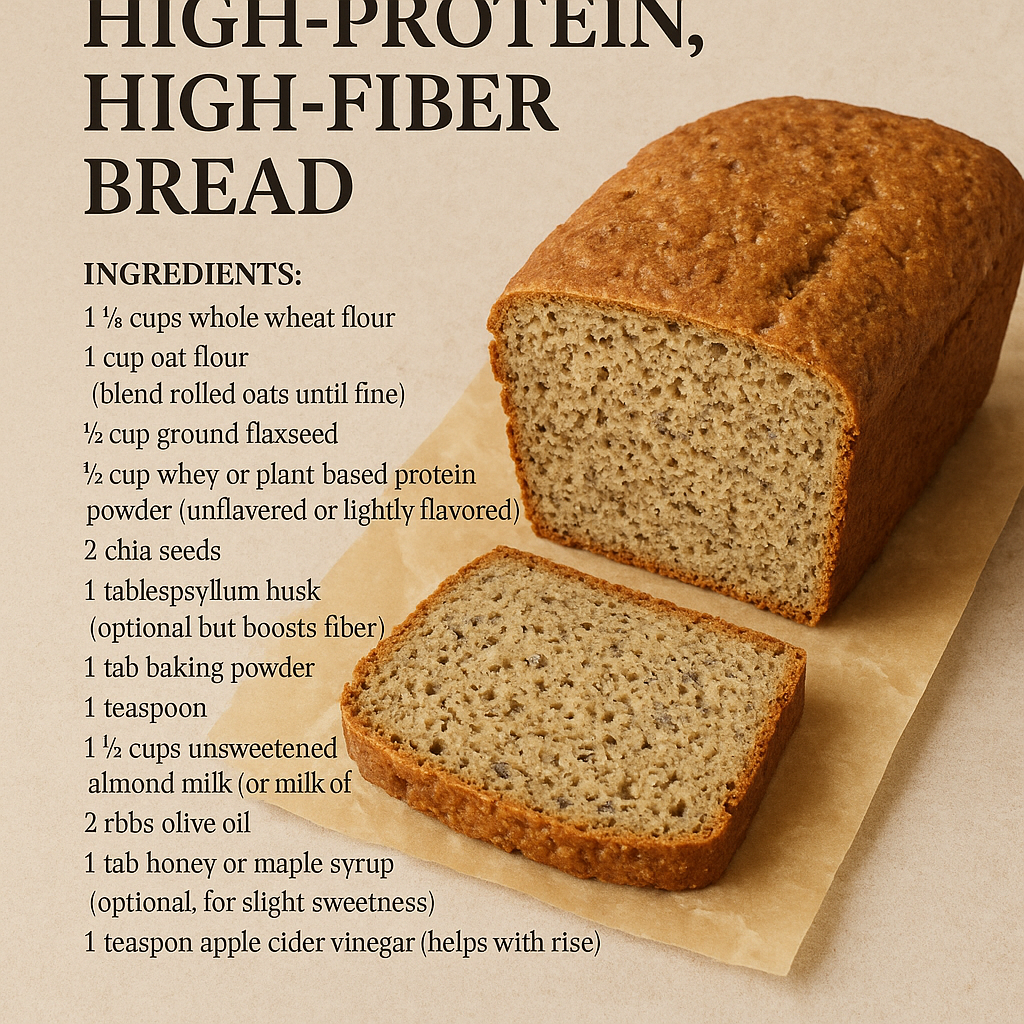
When it comes to bread, not all loaves are created equal. While supermarket shelves are lined with dozens of options—from white to whole wheat to “multigrain”—many of these commercially made breads fall short nutritionally. They’re often filled with refined flours, added sugars, preservatives, and minimal fiber or protein. That’s where homemade, high-protein, high-fiber bread comes in—a powerful, nutrient-dense alternative that supports energy, digestion, and overall health.
Packed with Protein and Fiber
This homemade bread is packed with whole food ingredients like whole wheat flour, oats, flaxseed, chia seeds, and protein powder. Just one slice delivers around 5 grams of protein and 4 grams of fiber—significantly more than typical white or even many store-bought whole wheat breads, which often contain only 2–3 grams of each. This combination keeps you full longer, supports muscle repair, and helps stabilize blood sugar levels, making it an excellent choice for breakfast or a post-workout snack.
No Additives or Preservatives
Unlike many commercial breads that rely on artificial preservatives, dough conditioners, and stabilizers to increase shelf life and texture, this bread is made with clean, simple ingredients. It contains nothing you can’t pronounce—just wholesome grains, seeds, and natural plant-based fats. That means fewer processed chemicals entering your body, which may support better digestion and reduce inflammation in sensitive individuals.
Promotes Digestive and Heart Health
The blend of flaxseed, chia seeds, and psyllium husk provides a rich source of omega-3 fatty acids and soluble fiber. These compounds are known to support heart health by lowering LDL cholesterol and improving triglyceride levels. Soluble fiber also nourishes gut bacteria, aiding in digestion and promoting regularity.
Low Glycemic and Blood Sugar Friendly
Refined breads can spike blood sugar rapidly due to their low fiber and high glycemic index. The complex carbohydrates and fiber in this homemade bread slow down digestion and glucose absorption, helping you maintain balanced energy throughout the day. This makes it a smarter option for people managing insulin sensitivity or diabetes.
Totally Customizable
When you bake at home, you control everything—from the type of flour to the protein source. Whether you use a plant-based protein powder, swap oat flour for almond flour, or add extra seeds, you can tailor it to your dietary preferences or food sensitivities. You also avoid added sugars and excessive sodium, which are common in commercial loaves.
Cost-Effective and Eco-Friendly
Making your own bread can be more cost-effective in the long run, especially when considering the nutritional density and the avoidance of unnecessary packaging and waste. You’re not just saving money—you’re investing in your health.
Ingredients
- 1 ¾ cups whole wheat flour
- 1 cup oat flour (blend rolled oats until fine)
- ½ cup ground flaxseed
- ½ cup whey or plant-based protein powder (unflavored or lightly flavored)
- 2 tbsp chia seeds
- 1 tbsp psyllium husk (optional but boosts fiber)
- 1 tbsp baking powder
- 1 tsp salt
- ½ cups unsweetened almond milk (or milk of choice)
- 2 tbsp olive oil
- 1 tbsp honey or maple syrup (optional, for slight sweetness)
- 1 tsp apple cider vinegar (helps with rise)
Instructions
1. Preheat oven to 350°F (175°C). Line a loaf pan with parchment paper or grease lightly.
2. Mix dry ingredients: In a large bowl, combine whole wheat flour, oat flour, flaxseed, protein powder, chia seeds, psyllium husk, baking powder, and salt.
3. Mix wet ingredients: In another bowl, whisk together almond milk, olive oil, honey/maple syrup, and apple cider vinegar.
4. Combine: Add wet ingredients to the dry ingredients. Stir until just combined. The batter will be thick—add a splash more milk if too dry.
5. Transfer to loaf pan. Smooth the top.
6. Bake for 40–50 minutes, or until a toothpick comes out clean and the top is golden.
7. Cool completely before slicing for best texture.
Summary
This high-protein, high-fiber bread is more than just a healthy alternative—it’s a nutritional upgrade. With whole ingredients, impressive macros, and zero additives, it outperforms most supermarket breads in almost every category. Whether you’re focused on fitness, digestion, or clean eating, making your own bread at home is a small change with big benefits.

